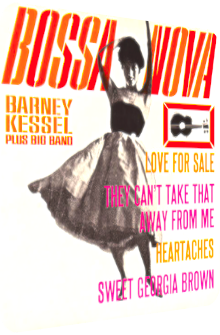
Barney Kessel
Bossa Nova
1961
"It has been my desire to create a new sound which people will want to hear over and over, a sound which they will be able to understand immediately and to which they will be unable to resist dancing – with or without partner" writes renowned Jazz guitarist Barney Kessel (1921–2004) himself in the liner notes of his album Bossa Nova, released in 1961 on Reprise Records. And rest assured that Kessel in tandem with arranger Bob Florence fulfills this desire time and again, whether it is fueled by his own needs or the craving of his fans. On Bossa Nova, though, this desire remains unfulfilled, but what may seem to you as a first tentative attempt of panning the album could not be farther from my endeavor.
The 12 renditions Kessel presents with his big band are indeed highly innovative in that they transform and reinvent classic material and pour it into the Bossa Nova mould. No particular style can escape Kessel, whether it is Blues, Mambo or piano arrangements in general, everything on this album is driven by the Bossa Nova rhythm, gorgeous brass blasts of the friendly and embracing kind and Kessel's work on the lead guitar. Strangely enough, it is his guitar work that remains unexpectedly pale compared to the furious brass rivers. What works well in trio or sextet form – especially so on his Exotica work of 1963 with the less than optimal title Contemporary Latin Rhythms – is not overly enjoyable here. Bossa Nova and Latin fans will not mind Kessel's weaker guitar, maybe even reversely see it as an added bonus in-between the interplay of the surfaces. However, his fans probably want to feast on the guitar God's riffs and eclectic patterns, and these are simply not good enough on this album. That said, I will write in greater detail about this perception in the final paragraph, so do not let these shadows distract you from the sunny side of this album, as there are enough gorgeous tidbits and intersections on board to even lure the Exotica fan.
The Bossa Nova subgenre or style can mean multitudinous things to many people, as stated in the opening paragraph. Barney Kessel and band decide to open the LP with punchy jumpiness: Cole Porter's Love For Sale comprises of a dialog between dirty saxes and gleaming trumpets of the euphoric kind. Kessel joins the fun with his guitar. The actual star besides the brass waves, however, is the organ played by Ray Johnson which is playing the backing chords, but occasionally plays parts of the main melody as well. Love For Sale is a joyful ditty in the given form, one that, in the end, cannot compete with one of my favorite interpretations out there by the Kokee Band led by Arthur Baum (off their LP Exotica 1970 from 1966). The same can be said about Eddie DeLange's String Of Pearls which decelerates the tempo, but interweaves sizzling-hot micro solos of Kessel's guitar which fill the blanks between the warm-hearted brass sections. A liminal Crime Jazz iniquity is perceptible due to the show tune stabs. Gorgeous organ spirals then reside in figurative poppy fields and function as the antipode.
While Barney Kessel's take on George Gershwin's song from the 1937 dance flick Shall We Dance, named They Can't Take That Away From Me, launches with deep tuba blasts, moves over to a rising theme of staccato glitz and is further ennobled by the band leader's Acid Jazz riffs plus its cool Bop organ droplets, the rendition of Ira Gershwin's Summertime has that city-strolling beat to it. Barney Kessel's guitar mediates between a Surf Rock tonality and a metropolitan concrete jungle scheme. The brass mettle is crunchy as usual, but it is the magnificent euphony of the brighter parts that enter the song like sunbursts which are the actual feat of the arrangement. A summer feeling is really encapsulated in there.
Up next is You Came A Long Way From St. Louis, originally written by John Benson Brooks, and it is here where Kessel and his big band capture the prohibition phase of the 30's with all the sleazy trumpets and sneaky trombones; these are then united with bandmate Ray Johnson's modern organ bubbles, dark guitar strings and a classic drum kit aorta. Side A closes with Kid Ory's 1926 gold standard Muskrat Ramble, a swinging big band piece that shows Kessel's true skills on the guitar, for the complex chords jump through many states and tone pitches. The melody is so convoluted that it becomes more memorable through its pattern than the actual melody, but the embracing show tune horns provide the missing link and make this designedly labyrinthine rendition a jovial one that is easier to consume.
Side B opens with Al Hoffman's and John Klenner's Heartaches, and huzzah, the Hammond B3 organ is finally featured big time, constantly surprising with a wonky cacophony and bachelor pad-compatible hooks. Kessel's guitar is definitely outshone here, the novelty of the organ flecks is simply too luring. It Ain't Necessarily So by brothers George and Ira Gershwin brings the first feeling of Latin mannerisms to the table, if only partly: an ascending hot-blooded horn motif is ennobled by Kessel's play on his signature instrument in a Space-Age way. The guitar is squeaking liquidly, the brass bursts evoke the heat of a night at a posh club with added slivers of futurism woven in. It is amazing how the helix of trumpets and trombones transforms the piano nucleus of this arrangement.
Whereas the interpretation of Bob Carlton's Jada tends more towards the complexion of a sun-soaked Mambo rather than a Bossa Nova physiognomy due to the convivial luminescence of the polyphonous brazen soundscape and Kessel's eminently gleeful guitar work, the following Sweet Georgia Brown by the trio of Ben Bernie, Kenneth Casey and Maceo Pinkard is the properly Latinized inclusion on this album with short outbursts of lamenting trumpets and an admixed Dixieland-evoking presentation thrown in for good measure. The wild organ, the fast rhythm and the incessant tendency to a swinging clime make this an indifferent but excellent hybrid.
The take on Bob Nolan's Tumbling Tumbleweeds really takes the cake though, as the world-famous downwards spiraling six-note leitmotif is played by Kessel's coruscating guitar and placed in a swinging upbeat rhythm with a legato organ and partly lamenting brass layers. This style is only consequent, as Nolan's original already implies a mildly nosy and ranting scope that becomes unfortunately diluted during smarmy partner dance events in a big city hall of your choice. Notwithstanding this sad trend, the big band plays it differently enough to take a stand of some sort. Barney Kessel departs with Bye, Bye Blues bye… I mean by Bert Lown and Chauncey Gray. The tempo is again viewed through the Bossa Nova style guide. Why does it matter? Because Lown's original vision of a Blues is delicately mocked in two ways: firstly by the tempo, secondly by the mood. This is one of the sweetest and most swinging tunes of the whole album, with quirky organ melodies and a strong brass- and percussion-related injection of euphoria. Its afterglow reverberates when the LP has finished playing.
If you read the middle section of this review, the following conclusion might surprise you, but I tend to think the following about this work: Bossa Nova is a curious album by Barney Kessel's standards. Well, curious can again mean as many things to even more people than the Bossa Nova-related rules and references, so let me stress that, for a lead guitarist, Kessel is strangely underused on this brass-heavy record. It is one thing to let the band members shine, but another one for the guitar to have a low-level profile. Bossa Nova is a good album, lives up to its name and features many innovative renditions, or rather transformations. That this album is a well-known entry of Barney Kessel's oeuvre is probably the surprising revelation, i.e. that it is also Kessel who carved out the idea, not just Enoch Light (as on his 1962 work Big Band Bossa Nova) or Xavier Cugat (who delivered a similarly themed 1955 release Merengue! By Cugat!, among many others). Bossa Nova sure was a hot trend around '61 and '62.
Considering Kessel's much more intimate and playful works, the big band, while playing entirely fine and swinging, proves to be a burden, not for the listener, but Kessel himself whose talent cannot unfold in the eclectic yet harmonious way he is known for. If you are fond of Mr. Kessel, but shake your head about the theses I have just exposed as they mean anything to you and do not prevent you from enjoying a good big band setting, then by all means, go get this album! The Bossa Nova version of Tumbling Tumbleweeds, the oversaturated good mood (!) of Bye, Bye Blues as well as the cityscape of George Gershwin's hymn Summertime are perfect transition pieces and well arranged. It is just that Barney Kessel does hardly place a terrifically innovative guitar solo or riff among the warm-hearted and euphonious horn bursts. Latin fans who favor the mellow, friendly mood over both themes of doleful gloom and a standardized hot-blooded affection should check it out regardless.
Exotica Review 231: Barney Kessel – Bossa Nova (1961). Originally published on Jun. 22, 2013 at AmbientExotica.com.
